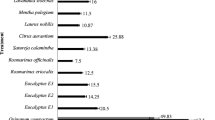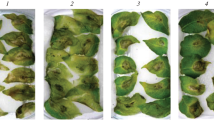Abstract
The effect of Yersinia pseudotuberculosis, the bacterial pathogen affecting humans and animals, on growth of ginseng (Panax ginseng C.A. Mey) cell cultures was studied. The bacteria strongly induced the expression of phenylalanine ammonia-lyase and β-1,3-glucanase, the proteins encoded by the defense-related genes of ginseng and inhibited the normal ginseng callus growth but did not affect the resistant cell cultures. The thermostable and thermolabile protein toxins of these bacteria are lethal to mice when induced parentherally, and they also induced the expression of the defense-related genes in ginseng callus cultures. At the same time, the ginseng cells completely suppressed the bacterial cell growth. These data suggest that the ginseng cells recognized the yersinia and developed the immune response to this pathogen. The interaction between the ginseng cells and Y. pseudotuberculosis is similar to the hypersensitive response of plants to plant pathogens.
Similar content being viewed by others
Abbreviations
- Avr:
-
avirulence
- CFU:
-
colony-forming unit
- HR:
-
hypersensitive response
- hrp :
-
hypersensitive response and pathogenicity genes
- PAL:
-
phenylalanine ammonia-lyase
- Pgglu1:
-
Panax ginseng β-1,3-glucanase
- PgPAL:
-
P. ginseng PAL
- TLTYp:
-
thermolabile toxin of Yersinia pseudotuberculosis
- TSTYp:
-
thermostable toxine of Y. pseudotuberculosis
- Yop:
-
Yersinia outer protein
References
Rozhkova, L.P. and Sharapova, T.A., Further Inquiry of Far-East Scarlet-Like Fever, Dal’nevostochnaya skarlatinopodobnaya likhoradka (psevdotuberkulez cheloveka) (Far-East Scarlet-Like Fever(Human Pseudotuberculosis)), Somov, G.P., Ed., Leningrad: Poligraficheskii Kombinat “Rotaprint”, 1978, pp. 13–24.
Somov, G.P., Varvashevich, T.N., and Timchenko, N.F., Psikhrofil’nost’ patogennykh bakterii (Psychrophilic Pity Pathogenic Bacteria), Moscow: Nauka, Sibirskoe Otdelenie, 1991.
Kuznetsov, V.G. and Bagryantsev, V.N., Ecology of Yersinia and Yersiniosis, Okruzhayushchaya sreda i zdorov’e naseleniya Vladivostoka (Environment and the Health of Vladivostok Inhabitants), Kosolapov, A.B. and Preobrazhenskii, B.V., Eds., Vladivostok: Dal’nauka, 1998, pp. 154–164.
Somov, G.P., Dal’nevostochnaya skarlatinopodobnaya likhoradka (Far-East Scarlet-Like Fever), Moscow: Meditsina, 1979.
Gordeiko, V.A. and Shustrova, N.M., Yersinia in Plants, Zh. Mikrobiol., Epidemiol. Immun., 1990, no. 11, pp. 16–18.
Markova, Yu.A., Romanenko, A.S., Igumnova, E.K., and Salyaev, R.K., Plants as Possible Reservoirs for Bacterial Pathogens of Human and Animals, Dokl. Akad. Nauk, 2002, vol. 386, pp. 277–279.
Shustrova, N.M., Misurenko, E.N., and Litvin, V.Yu., Possible Transfer of Yersinia pseudotuberculosis by Chain Soil-Plant-Animal, Zh. Mikrobiol., Epidemiol. Immun., 1992, no. 4, pp. 10–12.
Litvin, V.Yu., Gintsburg, A.L., Pushkareva, V.I., Romanova, Yu.M., and Boev, B.V., Epidemiologicheskie aspekty ekologii bakterii (Epidemiological Aspects of Bacterial Ecology), Moscow: Farmus-print, 1998.
Markova, Yu.A., Romanenko, A.S., Klimov, V.T., and Chesnokova, M.V., Relationships of Yersinia pseudotuberculosis and Potato Plants In Vitro, Zh. Stress. Fiziol. Biokh., 2006, vol. 2, no. 1, pp. 22–27.
Baker, B., Zambryski, P., Staskawicz, B., and Dinesh-Kumar, S.P., Signaling in Plant-Microbe Interactions, Science, 1997, vol. 276, pp. 726–733.
Rahme, L.G., Ausubel, F.M., Cao, H., Drenkard, E., Goumnerov, B.C., Lau, G.W., Mahajan-Miklos, S., Plotnikova, J., Tan, M., Tsongalis, J., Walendziewicz, C.L., and Tompkins, R.G., Plants and Animals Share Functionally Common Bacterial Virulence Factors, Proc. Natl. Acad. Sci. USA, 2000, vol. 97, pp. 8815–8821.
Staskawicz, B.J., Mudgett, M.B., Dangl, J.L., and Galan, J.E., Common and Contrasting Themes of Plant and Animal Disease, Science, 2001, vol. 292, pp. 2285–2289.
Hammond-Kosack, K.E. and Jones, J.D.G., Resistance Gene-Dependent Plant Defense Responses, Plant Cell, 1996, vol. 8, pp. 1773–1791.
Scofield, S.R., Tobias, Ch.M., Rathjen, J.P., Chang, J.H., Lavelle, D.T., Michelmore, R.W., and Staskawicz, B.J., Molecular Basis of Gene-for-Gene Specificity in Bacterial Speck Disease of Tomato, Science, 1996, vol. 274, pp. 2063–2065.
Orth, K., Xu, Z., Mudgett, M.B., Bao, Z.Q., Palmer, L.E., Bliska, J.B., Mangel, W.F., Staskawicz, B.J., and Dixon, J.E., Disruption of Signaling by Yersinia Effector YopJ, a Ubiquitin-Like Protein Protease, Science, 2000, vol. 290, pp. 1594–1597.
Timchenko, N.F., Bulgakov, V.P., Bulakh, E.V., Yasnetskaya, E.G., and Zhuravlev, Yu.N., Relationships between Yersinia, Listeria, and Salmonella and Plant Cells, Zh. Mikrobiol., Epidemiol. Immun., 2000, no. 1, pp. 6–10.
Timchenko, N., Eliseikina, M., Bulgakov, V., Bulakh, E., Yasnetskaya, E., Nedashkovskaya, E., and Zhuravlev, Yu., Yersinia pseudotuberculosis, Its Toxins and Plant Cells, Adv. Exp. Med. Biol., 2003, vol. 529, pp. 169–171.
Bulgakov, V.P., Kozyrenko, M.M., Fedoreyev, S.A., Mishenko, N.P., Denisenko, V.A., Zvereva, L.V., Pokushalova, T.V., and Zhuravlev, Yu.N., Shikonin Production by p-Fluorophenylalanine-Resistant Cells of Lithospermum erythrorhizon, Fitoterapia, 2001, vol. 72, pp. 394–401.
Alfano, J.R. and Collmer, A., Bacterial Pathogens in Plants: Life up against the Wall, Plant Cell, 1996, vol. 8, pp. 1683–1698.
Bulgakov, V.P., Khodakovskaya, M.V., Labetskaya, N.V., Chernoded, G.K., and Zhuravlev, Yu.N., The Impact of Plant rolC Oncogene on Ginsenoside Production by Ginseng Hairy Root Cultures, Phytochemistry, 1998, vol. 49, pp. 1929–1934.
Kiselev, K.V., Kusaykin, M.I., Dubrovina, A.S., Bezverbny, D.A., Zvyagintseva, T.N., and Bulgakov, V.P., The rolC Gene Induces Expression of a Pathogenesis Related β-1,3-Glucanase in Transformed Ginseng Cells, Phytochemistry, 2006, vol. 67, pp. 2225–2231.
Timchenko, N.F., Nedashkovskaya, E.P., Dolmatova, L.S., and Somova-Isachkova, L.M., Toksiny Yersinia rseudotubersulosis (Yersinia pseudotuberculosis Toxins), Vladivostok: Primorskii Poligrafkombinat, 2004.
Bradford, M.M., A Rapid and Sensitive Method for the Quantitation of Microgram Quantites of Protein Utilizing the Principle of Protein-Dye Binding, Anal. Biochem., 1976, vol. 86, pp. 248–254.
Yasnetskaya, E.G., Bulgakov, V.P., Gorbach, V.I., Shevchenko, N.M., Fedoreeva, L.I., Zhuravlev, Yu.N., and Kiselev, K.V., Ethephon-and Jasmonate-Elicited Pathogenesis-Related Ribonucleases in Cultured Ginseng Cells, Russ. J. Plant Physiol., 2003, vol. 50, pp. 554–560.
Gorpenchenko, T.Y., Kiselev, K.V., Bulgakov, V.P., Tchernoded, G.K., Bragina, E.A., Khodakovskaya, M.V., Koren, O.G., Batygina, T.B., and Zhuravlev, Yu.N., The Agrobacterium rhizogenes rolC-Gene-Induced Somatic Embryogenesis and Shoot Organogenesis in Panax ginseng Transformed Calluses, Planta, 2006, vol. 223, pp. 457–467.
Bulgakov, V.P., Veselova, M.V., Tchernoded, G.K., Kiselev, K.V., Fedoreyev, S.A., and Zhuravlev, Yu.N., Inhibitory Effect of the Agrobacterium rhizogenes rolC Gene on Rabdosiin and Rosmarinic Acid Production in Eritrichium sericeum and Lithospermum erythrorhizon Transformed Cell Cultures, Planta, 2005, vol. 221, pp. 471–478.
Kiselev, K.V., Gorpenchenko, T.Y., Tchernoded, G.K., Dubrovina, A.S., Grishchenko, O.V., Bulgakov, V.P., and Zhuravlev, Yu.N., Calcium-Dependent Mechanism of Somatic Embryogenesis in Panax ginseng Cell Cultures Expressing the rolC Oncogene, Mol. Biol., 2008, vol. 42, pp. 275–285.
Cramer, C.L., Edwards, K., Dron, M., Liang, X., Dildine, S.L., Bolwell, G.P., Dixon, R.A., Lamb, C.J., and Schuch, W., Phenylalanine Ammonia-Lyase Gene Organization and Structure, Plant Mol. Biol., 1989, vol. 12, pp. 367–383.
Zhu, M., Shao, F., Innes, R.W., Dixon, J.E., and Xu, Z., The Crystal Structure of Pseudomonas Avirulence Protein AvrPphB: A Papain-Like Fold with a Distinct Substrate-Binding Site, Proc. Natl. Acad. Sci. USA, 2004, vol. 101, pp. 302–307.
Hueck, C.J., Type III Protein Secretion Systems in Bacterial Pathogens of Animals and Plants, Microbiol. Mol. Biol. Rev., 1998, vol. 62, pp. 379–433.
Kunik, T., Tzfira, T., Kapulnik, Y., Gafni, Y., Dingwall, C., and Citovsky, V., Genetic Transformation of HeLa Cells by Agrobacterium, Proc. Natl. Acad. Sci. USA, 2001, vol. 98, pp. 1871–1876.
Lacroix, B., Tzfira, T., Vainstein, A., and Citovsky, V., A Case of Promiscuity: Agrobacterium’s Endless Hunt for New Partners, Trends Genet., 2006, vol. 22, pp. 29–37.
Bulgakov, V.P., Kiselev, K.V., Yakovlev, K.V., Zhuravlev, Yu.N., Gontcharov, A.A., and Odintsova, N.A., Agrobacterium-Mediated Transformation of Sea Urchin Embryos, Biotechnol. J., 2006, vol. 1, pp. 454–461.
Author information
Authors and Affiliations
Corresponding author
Additional information
Original Russian Text © E.V. Persiyanova, K.V. Kiselev, V.P. Bulgakov, N.F. Timchenko, G.K. Chernoded, Yu.N. Zhuravlev, 2008, published in Fiziologiya Rastenii, 2008, Vol. 55, No. 6, pp. 834–841.
Rights and permissions
About this article
Cite this article
Persiyanova, E.V., Kiselev, K.V., Bulgakov, V.P. et al. Defense response mechanisms of ginseng callus cultures induced by Yersinia pseudotuberculosis, a human pathogen. Russ J Plant Physiol 55, 748–755 (2008). https://doi.org/10.1134/S1021443708060034
Received:
Published:
Issue Date:
DOI: https://doi.org/10.1134/S1021443708060034




